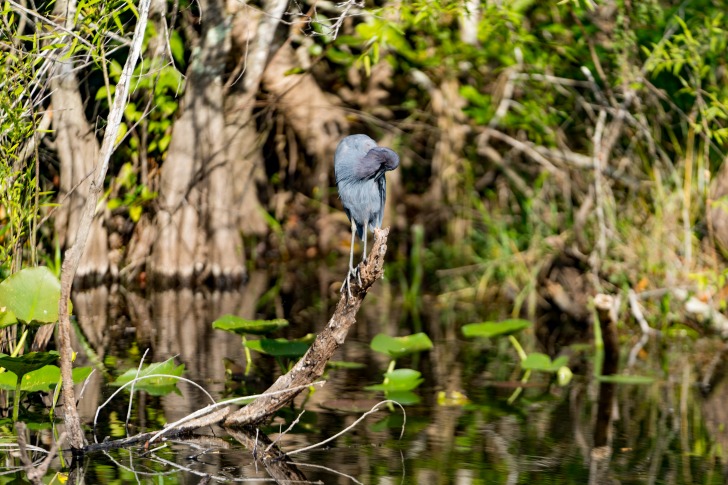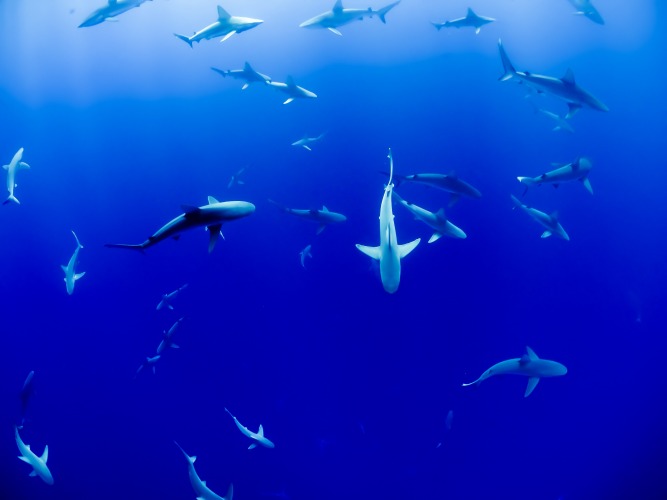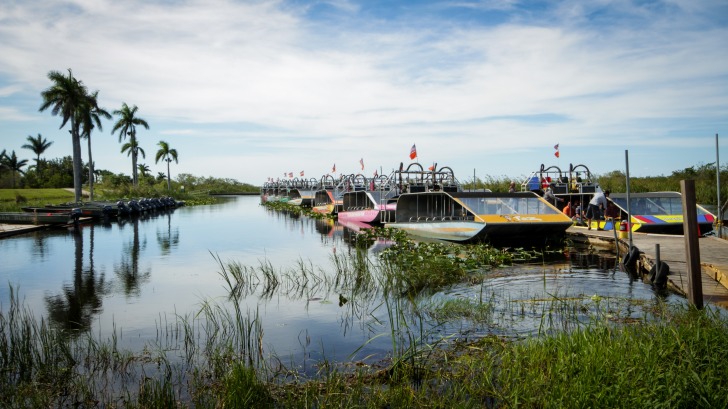Yes, sharks are in the Everglades.
The Everglades encompasses more than 1.5 million acres of wetlands in Florida.
This includes the protected Everglades National Park, which is home to Florida panthers, Miami blackheaded snakes, leatherback turtles, and wood storks.
Marshes and flatwoods, this is the only place on the planet where both crocodiles and alligators live side by side–but do not crossbreed because they are too genetically different.
Find out more about the types of sharks inhabiting and breeding in these Floridian waters.
Contents
So… Are There Sharks in the Everglades?
As for sharks, there are several species of sharks that live in the Everglades.
The Everglades are home to waterways in the largest subtropical location in the US. The subtropical waters here include marshes, swamps, and lagoons where freshwater and saltwater mingle.
It is also home to bull sharks, which actively breed in the waterways.
“Bull sharks (Carcharhinus leucas) use the bays and upstream areas of the southwest Everglades National Park Shark River basin as a nursery. These habitats support many juvenile sharks where they are an important top predator,” according to the Everglades Predators Research Projects.
These bull sharks live in the lagoons and waters leading into the oceans surrounding the state.
In terms of habitat, bull sharks coincide with crocodiles and alligators in these waters.
They are the prey of crocodiles and sharks like small bull sharks.
However, once they grow to be adult bull sharks, they become prey to humans via commercial fishing.

Bull Sharks
Bull sharks live in the Everglades of Florida.
This species of fish swims in freshwater coastal rivers and streams, as well as slow-moving water.
Bull sharks can be found around the world in other tropical and warm environments.
Lemon Sharks
Lemon sharks, according to the Florida Museum, have a signature yellow skin that glitters against the sandy bottom of the sea.
This is a form of camouflage that also leads to the name, lemon shark.
Similar to hammerheads, lemon sharks have broad dorsal fins across the bottom of their bodies.
Additionally, you can see two triangular dorsal fins along the spine of this shark.
Blacktip Sharks
Blacktip sharks are native to the Atlantic Ocean around the Florida coast.
Like lemon sharks, these sharks prefer saltwater, but they will live in lagoons, mangroves, and slow-moving rivers that meet the sea.
They have a z-shaped or triangle-shaped black line on their sides and are brown or gray with a white belly.
The blacktip shark reaches up to six feet in length when fully grown.
Is it Safe to Swim in the Everglades?
No, you may not swim in the Everglades. “Swimming [and] snorkeling is prohibited in all canals, ponds, freshwater lakes, marked channels, and boat basins inside the park,” stated the National Park Service for the Everglades National Park.
This national park covers the entire tri-county area of 1.5 million acres.
Therefore, you will not be able to find a place, not in the Everglades National Park that is still in the Everglades to be able to swim.
The reason you cannot swim in the Everglades is because of the wildlife that inhabits the waters.
This includes sharks like the bull shark and lemon shark, as well as American alligators, caimans, and Nile crocodiles, plus many other types of crocs.
Interesting Shark Facts in the Everglades
One corner of the Everglades is in the Bermuda Triangle, which is plagued with mystery.
Therefore, it makes you wonder if there is any connection between the Bermuda Triangle and the number of reptile species and sharks that live here.
As such, there have been many instances of downed planes and missing ships with crews that are never found.
Could this be from the bull sharks that eat the human remains before they reach the bottom of the sea?
Some do believe so!
Sharks swimming in freshwater is not the norm.
Along with lacking the space needed to swim–can you imagine a great white shark trying to swim upstream in a shallow river–sharks need saltwater.
Most sharks cannot live outside of saltwater.
Saltwater is required to maintain the saltwater concentration in their bodies.
However, bull sharks are different.
A bull shark has a 50 percent salt concentration in its blood.
It is the only shark with this high ratio of fresh to salt concentration in its body.
Therefore, bull sharks can successfully breed and swim in some fresh water.
This includes lagoons, mangrove swamps, and rivers that flow directly into the sea.
Another shark that lives in both freshwater and saltwater is the Speartooth shark.
However, in general, sharks must swim in saltwater or they risk death.
Oceana explained, “Most sharks can only tolerate salt water, or at the very minimum, brackish water, so freshwater rivers and lakes are generally out of the question for species such as great white sharks, tiger sharks, and hammerhead sharks.”
This is due to salt retention.
As pointed out by National Geographic, sharks have to swim in saltwater to retain the level of salt needed for their cells.
Freshwater dilutes salt levels in sharks and can lead to bloating and death.
The water temperature must also be at a certain degree in both freshwater and saltwater where sharks live.
Most sharks live in water that is between 59 and 86 degrees Fahrenheit.
This is considered temperate water that is best suited for the activity of the larger sharks.
Smaller sharks also need temperate waters in order to not change temperatures too rapidly.
They are less capable of managing temperature fluctuations due to their smaller body size.
This water temperature is necessary for both freshwater and saltwater sharks.

3 Safety Tips for Swimming in Shark-infested Waters
- Do not swim while bleeding. This includes open wounds, as well as menstrual bleeding. Any blood is going to be sniffed out by sharks who are searching for food. If you are bleeding, they will use their high-powered odorous senses to find you faster than someone who is not already “wounded” in their opinion. If you have recently cut yourself, consider a swim in shark-infested waters to be out of the question. Give yourself time to heal, or you will be shark bait.
- Sharks are smart, and you cannot outsmart a shark, so you want to be capable of using your other senses. Start with keeping your eyes wide open. As long as you see the shark first, you have some capacity for dealing with getting away from it. A sneaky shark is more likely to attack you, winning with the element of surprise. However, if you see a shark, you can make loud sounds and movements to startle it before it even sees you. This can be the element of surprise that saves your life.
- Get some shark repellent. These are bands you attach to your body that give off electrical or magnetic energy to deter sharks. Some say the bands are not worth the money, but it might be useful to try if you are swimming in shark-infested waters. Comparable to mosquito-repellent bracelets, these arm and leg bands are sold with the promise of keeping sharks at bay. At the very least, the bands will make you think about sharks attacking you as you wear them. This will help you maintain that level of alertness that is important for survival. You are, after all, swimming with sharks in these infested waters we speak of here.
Summary
Sharks live in the Everglades and include bull sharks, one of the mid-sized predator sharks.
This is a shark adapted to both freshwater and saltwater habitats, making it more dangerous for humans swimming in the Everglades.
As a result, you cannot swim in the Everglades.
This is not permitted for anyone due to this being a danger to those in the Everglades National Park.
That means you can visit the park to see the sharks, but you will not be swimming with bull sharks in the Everglades any time soon.
Frequently Asked Questions
Are sharks fish or mammals?
Even though some people refer to sharks as mammals, this is wrong.
However, since sharks are so big, they are confused with marine mammals like orcas, dolphins, and porpoises.
Sharks are fish, bottom line.
Sharks lay eggs, unlike mammals that have live births, and obtain oxygen through gills, indicative of fish.
Whales like the killer whale aka orca are thought to be related to sharks.
This is due to their dangerous-sounding name and their predator status.
But killer whales and sharks are entirely different species of marine life.
Killer whales are mammals, while sharks are fish.
Are there great white sharks in the Everglades?
Surprisingly, yes!
Sometimes there will be a smaller great white shark that turns up in Everglades National Park.
As this is a national park, there are park rangers actively monitoring any such animal activity.
Therefore, reports of finding great whites in the waterways here are rare but real.
That’s right, this is not a hoax; you could actually see a great white shark in Everglades National Park.
What you want to look for is an activity in deeper water that is closer to the saltwater habitat of the Atlantic.
Shallow waters less than five feet deep would never be conducive to the survival of a great white.
What is so unique about the Everglades?
Located in Florida, the Everglades is the largest tropical and temperate landscape for wildlife.
There are more than 1.5 million acres here that are home to rare and exotic species of flora and fauna.
This includes the bull shark, lemon shark, and blacktip shark, as well as crocodiles and alligators.
In fact, this is the only place on the planet where gators and crocs coexist.
Plus, there are hundreds of bird species native to the wetlands and mangrove swamps in this region.
The Everglades are also protected by the federal government as the Everglades National Park.
Visitors come to the park to see the wildlife, including sharks, alligators, crocodiles, and Florida panthers living in the wild.












Bull sharks are fascinating creatures that have adapted to living in both freshwater and saltwater habitats, making them a unique and potentially dangerous species. It is important to respect their natural habitat and follow safety precautions when visiting areas where they reside.